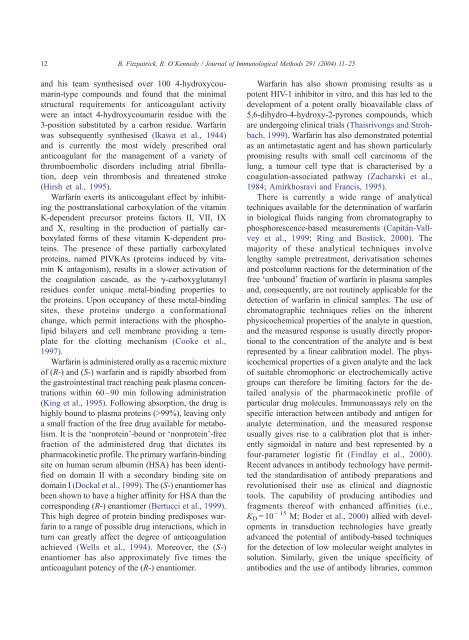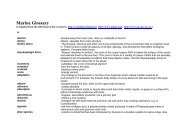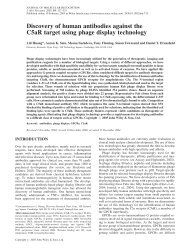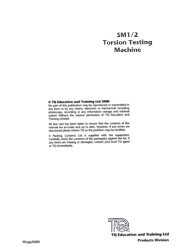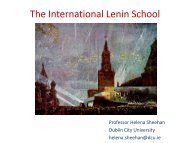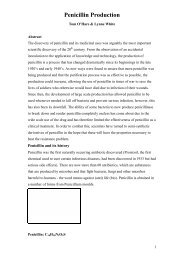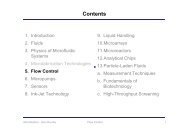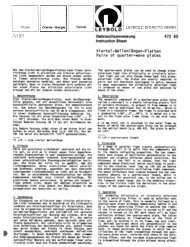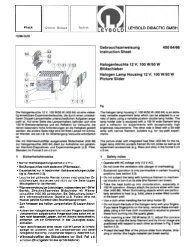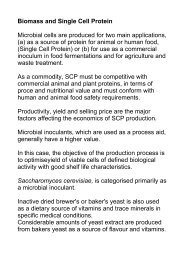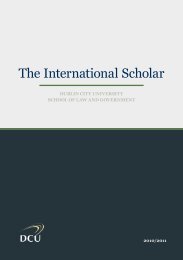The development and application of a surface plasmon ... - DCU
The development and application of a surface plasmon ... - DCU
The development and application of a surface plasmon ... - DCU
You also want an ePaper? Increase the reach of your titles
YUMPU automatically turns print PDFs into web optimized ePapers that Google loves.
12<br />
B. Fitzpatrick, R. O’Kennedy / Journal <strong>of</strong> Immunological Methods 291 (2004) 11–25<br />
<strong>and</strong> his team synthesised over 100 4-hydroxycoumarin-type<br />
compounds <strong>and</strong> found that the minimal<br />
structural requirements for anticoagulant activity<br />
were an intact 4-hydroxycoumarin residue with the<br />
3-position substituted by a carbon residue. Warfarin<br />
was subsequently synthesised (Ikawa et al., 1944)<br />
<strong>and</strong> is currently the most widely prescribed oral<br />
anticoagulant for the management <strong>of</strong> a variety <strong>of</strong><br />
thromboembolic disorders including atrial fibrillation,<br />
deep vein thrombosis <strong>and</strong> threatened stroke<br />
(Hirsh et al., 1995).<br />
Warfarin exerts its anticoagulant effect by inhibiting<br />
the posttranslational carboxylation <strong>of</strong> the vitamin<br />
K-dependent precursor proteins factors II, VII, IX<br />
<strong>and</strong> X, resulting in the production <strong>of</strong> partially carboxylated<br />
forms <strong>of</strong> these vitamin K-dependent proteins.<br />
<strong>The</strong> presence <strong>of</strong> these partially carboxylated<br />
proteins, named PIVKAs (proteins induced by vitamin<br />
K antagonism), results in a slower activation <strong>of</strong><br />
the coagulation cascade, as the g-carboxyglutamyl<br />
residues confer unique metal-binding properties to<br />
the proteins. Upon occupancy <strong>of</strong> these metal-binding<br />
sites, these proteins undergo a conformational<br />
change, which permit interactions with the phospholipid<br />
bilayers <strong>and</strong> cell membrane providing a template<br />
for the clotting mechanism (Cooke et al.,<br />
1997).<br />
Warfarin is administered orally as a racemic mixture<br />
<strong>of</strong> (R-) <strong>and</strong> (S-) warfarin <strong>and</strong> is rapidly absorbed from<br />
the gastrointestinal tract reaching peak plasma concentrations<br />
within 60–90 min following administration<br />
(King et al., 1995). Following absorption, the drug is<br />
highly bound to plasma proteins (>99%), leaving only<br />
a small fraction <strong>of</strong> the free drug available for metabolism.<br />
It is the ‘nonprotein’-bound or ‘nonprotein’-free<br />
fraction <strong>of</strong> the administered drug that dictates its<br />
pharmacokinetic pr<strong>of</strong>ile. <strong>The</strong> primary warfarin-binding<br />
site on human serum albumin (HSA) has been identified<br />
on domain II with a secondary binding site on<br />
domain I (Dockal et al., 1999). <strong>The</strong> (S-) enantiomer has<br />
been shown to have a higher affinity for HSA than the<br />
corresponding (R-) enantiomer (Bertucci et al., 1999).<br />
This high degree <strong>of</strong> protein binding predisposes warfarin<br />
to a range <strong>of</strong> possible drug interactions, which in<br />
turn can greatly affect the degree <strong>of</strong> anticoagulation<br />
achieved (Wells et al., 1994). Moreover, the (S-)<br />
enantiomer has also approximately five times the<br />
anticoagulant potency <strong>of</strong> the (R-) enantiomer.<br />
Warfarin has also shown promising results as a<br />
potent HIV-1 inhibitor in vitro, <strong>and</strong> this has led to the<br />
<strong>development</strong> <strong>of</strong> a potent orally bioavailable class <strong>of</strong><br />
5,6-dihydro-4-hydroxy-2-pyrones compounds, which<br />
are undergoing clinical trials (Thaisrivongs <strong>and</strong> Strohbach,<br />
1999). Warfarin has also demonstrated potential<br />
as an antimetastatic agent <strong>and</strong> has shown particularly<br />
promising results with small cell carcinoma <strong>of</strong> the<br />
lung, a tumour cell type that is characterised by a<br />
coagulation-associated pathway (Zacharski et al.,<br />
1984; Amirkhosravi <strong>and</strong> Francis, 1995).<br />
<strong>The</strong>re is currently a wide range <strong>of</strong> analytical<br />
techniques available for the determination <strong>of</strong> warfarin<br />
in biological fluids ranging from chromatography to<br />
phosphorescence-based measurements (Capitán-Vallvey<br />
et al., 1999; Ring <strong>and</strong> Bostick, 2000). <strong>The</strong><br />
majority <strong>of</strong> these analytical techniques involve<br />
lengthy sample pretreatment, derivatisation schemes<br />
<strong>and</strong> postcolumn reactions for the determination <strong>of</strong> the<br />
free ‘unbound’ fraction <strong>of</strong> warfarin in plasma samples<br />
<strong>and</strong>, consequently, are not routinely applicable for the<br />
detection <strong>of</strong> warfarin in clinical samples. <strong>The</strong> use <strong>of</strong><br />
chromatographic techniques relies on the inherent<br />
physicochemical properties <strong>of</strong> the analyte in question,<br />
<strong>and</strong> the measured response is usually directly proportional<br />
to the concentration <strong>of</strong> the analyte <strong>and</strong> is best<br />
represented by a linear calibration model. <strong>The</strong> physicochemical<br />
properties <strong>of</strong> a given analyte <strong>and</strong> the lack<br />
<strong>of</strong> suitable chromophoric or electrochemically active<br />
groups can therefore be limiting factors for the detailed<br />
analysis <strong>of</strong> the pharmacokinetic pr<strong>of</strong>ile <strong>of</strong><br />
particular drug molecules. Immunoassays rely on the<br />
specific interaction between antibody <strong>and</strong> antigen for<br />
analyte determination, <strong>and</strong> the measured response<br />
usually gives rise to a calibration plot that is inherently<br />
sigmoidal in nature <strong>and</strong> best represented by a<br />
four-parameter logistic fit (Findlay et al., 2000).<br />
Recent advances in antibody technology have permitted<br />
the st<strong>and</strong>ardisation <strong>of</strong> antibody preparations <strong>and</strong><br />
revolutionised their use as clinical <strong>and</strong> diagnostic<br />
tools. <strong>The</strong> capability <strong>of</strong> producing antibodies <strong>and</strong><br />
fragments there<strong>of</strong> with enhanced affinities (i.e.,<br />
K D =10<br />
15 M; Boder et al., 2000) allied with <strong>development</strong>s<br />
in transduction technologies have greatly<br />
advanced the potential <strong>of</strong> antibody-based techniques<br />
for the detection <strong>of</strong> low molecular weight analytes in<br />
solution. Similarly, given the unique specificity <strong>of</strong><br />
antibodies <strong>and</strong> the use <strong>of</strong> antibody libraries, common


